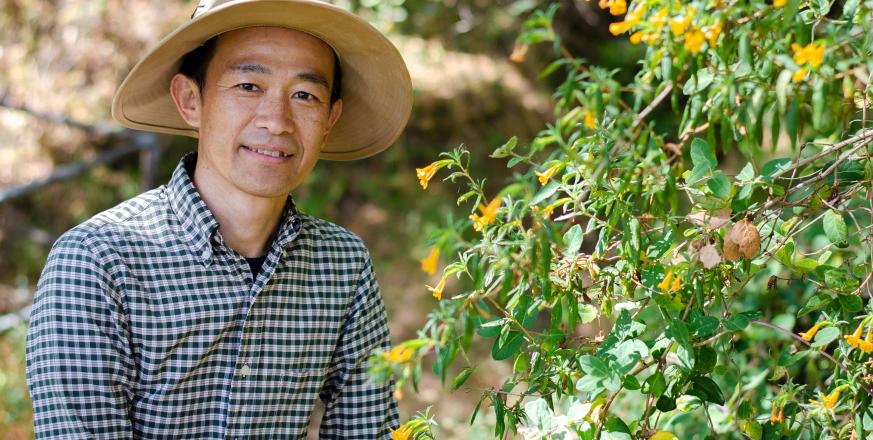Professor Tad Fukami is appointed Faculty Director of Jasper Ridge

Photo: Callie Chappell
Tadashi (Tad) Fukami, Professor of Biology and of Earth System Science, became the faculty director of Jasper Ridge on September 1. He succeeds Professor Liz Hadly, who has stepped down after serving for seven years. Tad is a leading community ecologist who is well known to the Jasper Ridge community for his research and teaching on the microbial ecology of floral nectar for the past 15 years.
Tad is widely recognized for developing, testing, and teaching theories of how species interact within ecological communities, especially in response to perturbations. In particular, Tad is a pioneer in elucidating how a community’s response can be constrained by previous events or conditions, including the chronology of disturbances such as fires or floods, which set the stage for new colonizations (historical contingency), or the order of their arrival (priority effects). Tad and his lab have applied this lens to a range of study systems—microbes, plants, birds, and freshwater communities—and a range of scales. For example, in his postdoctoral research Tad studied New Zealand islands invaded by rats and compared them with uninvaded islands, leading to new insights in invasion biology and soil microbiology. His research has been widely recognized and cited by many and in 2019 Tad and his past postdoctoral fellow Meike J. Wittmann received the American Society of Naturalists (ASN) Presidential Award for the best paper published in The American Naturalist, "Eco-Evolutionary Buffering: Rapid Evolution Facilitates Regional Species Coexistence despite Local Priority Effects." For his contributions across these disciplines and study systems, Tad was elected in 2019 as a Fellow of the Ecological Society of America and in 2022 received the Distinguished Naturalist Award from ASN. Tad became a full professor in the Department of Biology in 2021, and, in 2022, jointly with Earth System Science.
Tad’s role at Jasper Ridge began when he joined Stanford as an assistant professor in September 2008. He took a lead role in redesigning the “Core Undergraduate Lab in Ecology, BIO 44Y,” a course required of biology majors. Tad’s design, initially adopted as a pilot course, allows students to study interactions between Mimulus (or Diplacus) flowering phenology, hummingbird pollinators, and nectar-inhabiting microbes at Jasper Ridge.
This course mirrors a focus of Tad’s research—well-replicated ecological communities where one can use experimental manipulations to probe how species influence one another, such as using netting to exclude pollinators from Mimulus flowers, and seeing how this alters the nectar microbiome. Students work in small groups to formulate questions, combine field and laboratory measurements, and present results in the format of a scientific publication. Initially the course was itself an experiment, and members of the School of Education compared the experiences and perspectives of students taking simultaneous versions of the pilot and traditional courses. Their published results encouraged complete adoption of the new course. The enrollment expanded to more than a hundred students, making it JRBP’s largest integration of faculty research and teaching. In 2013, the course received the AAAS Science prize for Inquiry-Based Instruction.
Research by Tad’s lab is also asking parallel questions about microbial interactions in the nectar microbiome of Pedicularis densiflora (warrior plume).
Two areas of growing emphasis within Tad’s research and teaching have special significance for Jasper Ridge. His lab has found that when yeast and bacteria cohabit floral nectar, they can undergo rapid evolutionary changes as they influence one another, which in turn influences community interactions and nectar chemistry. This finding adds another example to the field of coevolution, a theory whose first formulation was inspired in part by observations at Jasper Ridge by Paul Ehrlich and Peter Raven in the 1960’s. The discovery also suggests a host of new tractable experiments.
Another area of growing emphasis for Tad is traditional ecological knowledge. Although Tad has excelled at formalizing theories and applying traditional scientific methods, his newest courses examine Indigenous views on ecology and the lens they provide on vegetation health.
In handing over the reins as faculty director, Professor Liz Hadly praised her successor, “Tad is the consummate professor. In addition to his scientific acumen, he will make a fine leader at Jasper Ridge. He is unfailingly kind, deft in his mentoring, deeply moral, and extraordinarily patient. His recent dedication to Traditional Ecological Knowledge (TEK) is synergistic with our priorities at Jasper Ridge. We will need all of Tad’s abilities as we deepen our stewardship at the preserve and I am confident that we are in good hands.”
Tad expressed his enthusiasm about his new role, "Ever since my arrival at Stanford, much of my research and teaching grew because of Jasper Ridge being there, supported by the many students, faculty, staff, and docents I was lucky to work with over the past 15 years. I am grateful and excited to be now given the opportunity to give back to this community in my new role as faculty director. I am looking forward to working with everyone to further promote research, education, and stewardship on this precious piece of land we have at Stanford."



